Yoga after dinner has been a helpful trend for some time now. However, many people are still unsure whether or not it’s okay to do yoga after eating. The simple answer is yes! Of course, you can practice yoga after a meal.
According to studies
and expert claims, yoga helps improve digestion, alleviate gastrointestinal symptoms, and aid in weight loss. It is true (for most people) that they frequently ignore the digestive system and do not take it seriously. Yet, indigestion comes with its own troubles.
Thanks to many therapies, including Yoga, you can enhance digestion and quicken weight reduction by simply adopting yoga into your routine. It not only stretches the back muscles and softens the spine, but it also moves food through the digestive system to ease constipation or the bloated sensation. This in turn relieves general stress levels and soothes the stomach, promoting restful sleep. Before drifting off into a restful night of deep slumber, practicing yoga is an excellent method to let go of anything you’re holding onto emotionally or physically. You may get better, longer sleep if you incorporate a calming yoga exercise into your evening routine. If you’re one of those who have trouble falling asleep, sleeplessness, or limited sleep time, you can greatly benefit from this.
Before we look into some of the Yoga styles that you can do, let’s talk about some of the health benefits.
Benefits of Yoga
1. Enhances life satisfaction and sleep quality
Yoga is a healthy substitute for prescription sleep aids, which are frequently prescribed to elderly people. The long-term consequences of yoga practice in older persons were examined by researchers in a study published in 2013. And in this study, they discovered that practicing yoga had an edge over the control group, who didn’t experience as many advantages, in terms of the quality of sleep and general quality of life.

2. Helps with insomnia
According to a 2020
publication by Havard Health
, around 55% of persons who practiced yoga reported that it improved their sleep as revealed by a national poll. Also, more than 85% of respondents claimed yoga helped them feel less stressed. In other words, regular yoga practice can help you control the effects of sleeplessness. If you engage in regular Yoga activities, you might be able to sleep longer, go to bed again after awakening at night, and fall asleep more quickly.
Some studies from 2019 show that yoga and some other mind-body practices can effectively alleviate insomnia and encourage restful sleep. Together with yoga, participants who did tai chi, qigong, and meditation reported better sleep. If you want to do Yoga, props that provide support, such as bolsters, blankets, and blocks, can make poses more bearable so that you can hold them for extended periods of time while continuing to breathe.
3. Aids in relaxing
Yoga may assist in triggering the relaxation response, which helps the body become peaceful. In contrast to the fight-or-flight reaction, you might be able to settle down and attain a lower state of arousal by practicing relaxing yoga positions. You might have a drop in blood pressure and cortisol levels due to this. This may aid in reducing issues brought on by stress, such as gaining weight, feeling anxious, and having trouble sleeping.
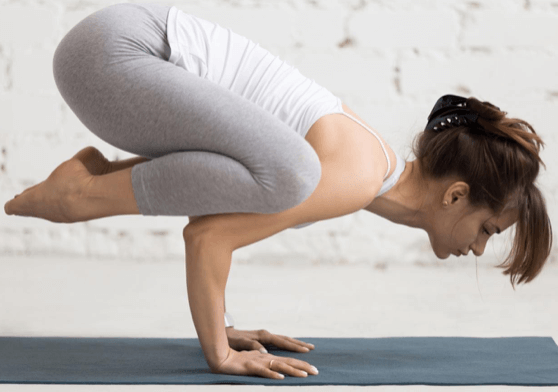
4. Slimming down
Many believe that weight loss and regular yoga practice have connections (which is obviously true). Yoga before bedtime may improve your quality of sleep, which supports weight loss and maintenance. It also helps you to become more conscious of your eating patterns could also be beneficial.
5. Aids Mental Consciousness
One of the major advantages of yoga, outside its physical health advantages, is the way it aids with stress management. Stress is known to have detrimental effects on the body and mind. Stress can manifest itself in a variety of ways, including headaches, back or neck pain, difficulty sleeping, substance misuse, and difficulty focusing. Yoga can be highly helpful in gaining coping mechanisms and a more optimistic attitude toward life.
A person’s mental health might be enhanced by practicing yoga because it incorporates breathing and meditation. Frequent yoga practice improves bodily awareness, reduces chronic stress patterns, relaxes the mind, directs attention, and sharpens concentration. It also fosters mental clarity and peace.
6 Yoga Poses to Practice
Most people usually face some trouble trying to get a good night’s sleep after dinner. Don’t worry if you have trouble falling asleep after dinner because I’m about to show you some Yoga poses that would help you alleviate the problem of finding sleep. When you have poor eating habits and a young age, it may be difficult to get good sleep. To prevent your sleep patterns from being disturbed, there are a few great yoga poses you can perform after dinner. After the night’s meal, you can practice some of the following yoga poses that may aid in a restful night’s sleep while helping with stomach problems.
1. Camel Pose (Ustrasana)
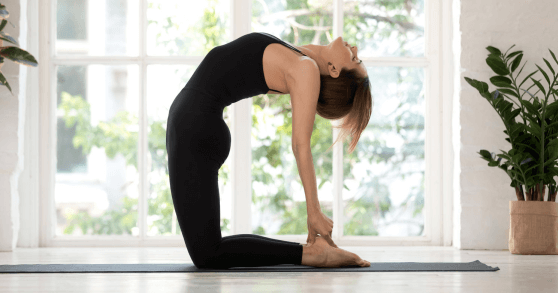
After eating, the camel stance in yoga is an excellent practice for the back and helps with digestion. To be honest, this stance can be a little challenging to do (especially for first-timers). Looking at it, one would think that it could be bad for the back. Yet, contrary to the misconception, research has demonstrated that in addition to improving the lower back, Ustrasana also relieves stomach troubles and promotes digestion.
2. Downward Dog Pose
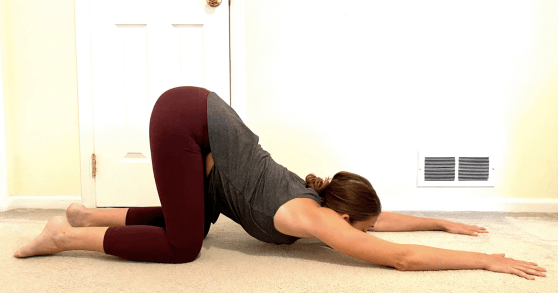
You can’t talk about the most well-known yoga positions without mentioning this one. Any time of day (morning, afternoon, evening) can be used to practice this stance. Some of the benefits of this stance are that it affects the abdomen, promotes improved bowel movement, and is simple to perform. To perform this stance, your palms should be somewhat wider than your shoulder apart. Continue raising your hips while having your toes tucked inward. Your thighs should move backward in unison with your chest and be sure to bend your knees. Keep in mind that holding the sole firmly rooted is less crucial than keeping the hips up. Maintain the position for roughly 10-15 seconds. Your body will thank you for it.
3. Child’s Pose (Balasana)
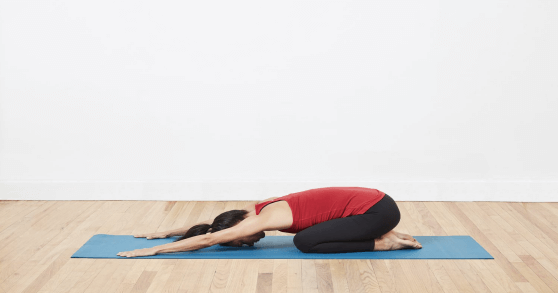
The child’s pose, or Balasana, is an additional asana that can aid to relieve indigestion and unwind an enlarged stomach. After supper, it ranks among the most potent yoga poses. From a kneeling position, start the Balasana pose by tucking your chest between your thighs while keeping your forehead on the ground. Maintain your arms parallel to your body and straight. Take several deep, slow breaths while maintaining this position for ten to fifteen seconds. The child pose is indeed very effective. However, it would be wise to avoid Balasana if you have knee issues or are pregnant because it applies pressure to the knees and stomach, which could be uncomfortable and make things worse.
4. Standing Forward Bend Pose
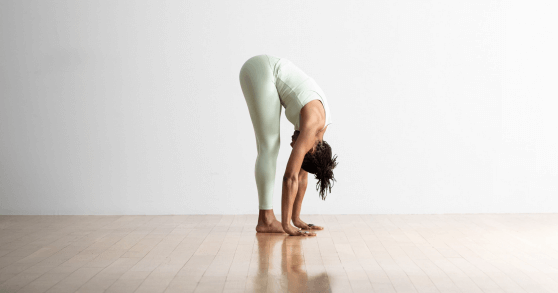
The forward-bending standing poses known as Uttanasana is beneficial for the digestive system. It aids in moving food through the digestive system and relieves bloating or constipation. Maintain a knee bend while performing this asana, and try to extend your arms over your tummy to grab the backs of both knees. Since the ideal sensation is tension in your hamstrings, try straightening your legs if there isn’t any strain in your body. Afterward, maintain the position for 15 to 20 seconds.
5. Bow Pose (Dhanurasana)
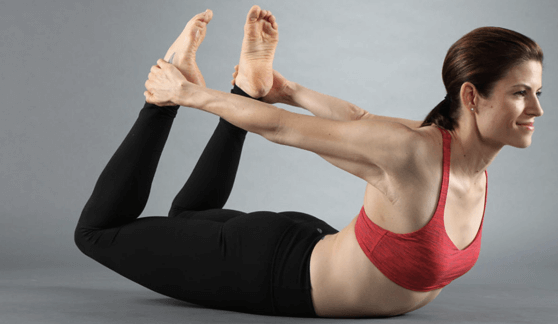
Another Yoga pose that is helpful for bloating and constipation relief is the bow position or Dhanurasana. Mere looking at this stance there’s no doubting the fact that it has a lot to do with the flexibility of the back. Over time, it has been demonstrated to support body flexibility and toning of the back and abdomen. It is a little difficult to execute and doesn’t seem very comfy; nevertheless, it is very effective. When you’ve reached your desired position, hold it for 15 to 20 seconds before releasing it.
6. Corpse Pose (Savasana)
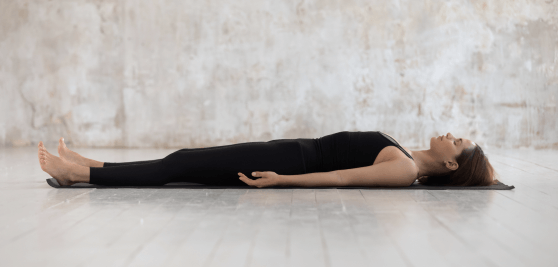
Some people prefer activities with less work/energy. The savasana stance, which is well-liked by less-active people, is intended to enhance bodily functions. It aids in your revitalization by assisting you in regaining the energy you’ve lost. It’s simple to move into place. Simply close your eyes while lying on your back and your palms up, facing the sky, and your hands close by your sides. Stay in place for 15 to 20 minutes. Focus on your breathing while keeping your eyes closed. For meditation, the seated posture of Padmasana is frequently replaced with this one. Typically, this pose should be the last one you do in yoga.
Conclusion
It’s a frequent misconception that yoga cannot be done shortly following a meal. Another widely held belief is that yoga is challenging and requires months or even years of practice to master. However, those beliefs may not be entirely true. These are really simple yoga positions that can be performed by anyone correctly after supper to enhance digestion and sleep to disprove both of these myths. Following a sweet dinner with a yoga session may help with digestion, bloating, and constipation.
After supper, practicing a few yoga positions is the ideal method to reduce discomfort and fall asleep peacefully. The aforementioned asanas promote digestion, alleviate constipation, lessen bloating, ease stomach discomfort, increase flexibility, and invigorate your body. They also help with bowel movements and gastrointestinal health. These positions are also simple to do and quite powerful. Try these positions after dinner and see the effects for yourself if you are having issues with digestion and finding it difficult to get a decent night’s sleep.

 By myulikeadmin
By myulikeadmin



